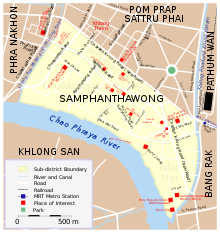
Bang Rak is one of the fifty districts (khet) of Bangkok, Thailand. It lies on the eastern bank of the Chao Phraya River, beyond Khlong Phadung Krung Kasem, which marked the old city boundary. Originating from riverside settlements dating from before the city's foundation, Bang Rak grew inland as new roads and canals were constructed through the area during the second half of the nineteenth century and the early twentieth, attracting communities of expatriates and developing into a major commercial district. Bangkok's rapid economic growth in the late twentieth century saw the areas along Si Lom and Sathon roads transformed into one of the city's main business districts, teeming with skyscrapers. The district, officially recognised at least since 1908, covers an area of 5.54 square kilometres (2.14 sq mi), and has a registered population of 48,227. Today, Bang Rak is known for the financial activity of its commercial offices, as well as its vibrant nightlife scenes. Diverse historic and religious sites, most significantly concentrated in Bang Rak Subdistrict on the waterfront, reflect the district's multicultural history.

Phra Nakhon is one of the 50 districts (khet) of Bangkok, Thailand. It is the central district of Bangkok, including Rattanakosin Island. Neighboring districts are, from the north, clockwise: Dusit, Pom Prap Sattru Phai, Samphanthawong, and across the Chao Phraya River, Thon Buri, Bangkok Yai, Bangkok Noi, and Bang Phlat.

Samphanthawong ; Chinese: 三攀他旺县) is one of the 50 districts (khet) of Bangkok, Thailand. Regarded as Bangkok's Chinatown, it is the smallest district by area in Thailand. Neighboring districts are Pom Prap Sattru Phai, Bang Rak, Khlong San, and Phra Nakhon.

Yaowarat Road in Samphanthawong District is the main artery of Bangkok's Chinatown. Modern Chinatown now covers a large area around Yaowarat and Charoen Krung Road. It has been the main centre for trading by the Chinese community since they moved from their old site some 200 years ago to make way for the construction of Wat Phra Kaew, the Grand Palace. Nearby is the Phahurat or Little India. The area is bordered by the Chao Phraya River from the west to the south. Yaowarat Road is well known for its variety of foodstuffs, and at night turns into a large "food street" that draws tourists and locals from all over the city.
The history of Bangkok, the capital of Thailand, dates at least to the early 15th century, when it was under the rule of Ayutthaya. Due to its strategic location near the mouth of the Chao Phraya River, the town gradually increased in importance, and after the fall of Ayutthaya King Taksin established his new capital of Thonburi there, on the river's west bank. King Phutthayotfa Chulalok, who succeeded Taksin, moved the capital to the eastern bank in 1782, to which the city dates its foundation under its current Thai name, "Krung Thep Maha Nakhon". Bangkok has since undergone tremendous changes, growing rapidly, especially in the second half of the 20th century, to become the primate city of Thailand. It was the centre of Siam's modernization in the late 19th century, subjected to Allied bombing during the Second World War, and has long been the modern nation's central political stage, with numerous uprisings and coups d'état having taken place on its streets throughout the years.
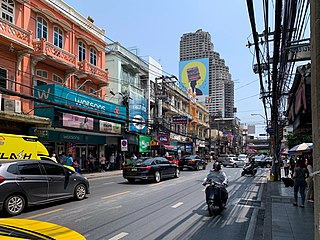
Charoen Krung Road is a major road in Bangkok and the first in Thailand to be built using modern construction methods. Built during 1862–1864 in the reign of King Mongkut, it runs from the old city centre in Rattanakosin Island, passes through Bangkok's Chinatown, continues into Bang Rak district, where it formerly served the community of European expatriates, and ends in Bang Kho Laem. Construction of the road marked a major change in Bangkok's urban development, with the major mode of transport shifting from water to land. Charoen Krung Road was Bangkok's main street up to the early 20th century, but later declined in prominence. It is still home to many historic buildings and neighbourhoods, which are beset by changes as extension of the underground MRT is poised to drive new development.

Wongwian Yai, also spelled "Wong Wian Yai" or "Wongwien Yai", is a large roundabout in Thonburi, on the west bank of the Chao Phraya River in Bangkok, Thailand, where the statue of King Taksin is situated.
Bangkok, the capital of Thailand, is one of the world's top tourist destination cities. Each year, approximately 22.7 million international visitors arrive in Bangkok. MasterCard ranked Bangkok as the world's top destination city, with 15.98 million projected visitors in 2013. It topped the MasterCard Global Destinations Cities Index as the most visited city in the world in 2012, 2013, 2016, 2017 and 2018. The city is ranked fourth in cross-border spending, with 14.3 billion dollars projected for 2013, after New York, London and Paris. Euromonitor International ranked Bangkok sixth in its Top City Destinations Ranking for 2011. Bangkok has also been named "World's Best City" by Travel + Leisure magazine's survey of its readers for four consecutive years since 2010.

Rattanakosin Island is a historic area in the Phra Nakhon District in the city of Bangkok, Thailand. It is bordered by the Chao Phraya River to the west and various canals to the east that were dug to serve as moats for what was originally the fortified city center. Situated on the eastern convex bank of a meander in the Chao Phraya River, the island is the site of the Grand Palace and Bangkok's City Pillar Shrine, among other places of historical significance.
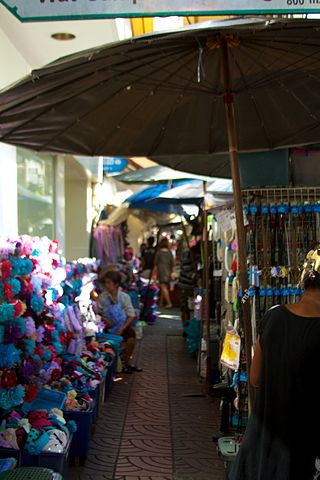
Sampheng is a historic neighbourhood and market in Bangkok's Chinatown, in Samphanthawong District. It was settled during the establishment of Bangkok in 1782 by Teochew Chinese, and eventually grew into the surrounding areas. The original street of Sampheng, now officially known as Soi Wanit 1, is now a small alleyway lined with numerous shops, and is a famous market.
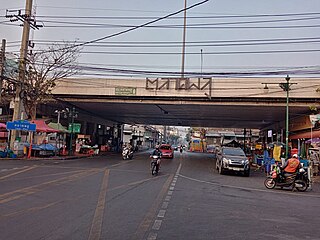
Talat Phlu or Talad Phlu is a community and marketplace by the canal Khlong Bangkok Yai in Talat Phlu subdistrict, Thon Buri district, Thonburi side of Bangkok.

Tha Din Daeng is a market and one of the oldest neighbourhoods in Bangkok. It is in the Somdet Chao Phraya and Khlong San Subdistricts of Khlong San District on the Thonburi side.

Saphan Han is a small bridge over the Khlong Rop Krung, also known as Khlong Ong Ang in the areas of Bangkok's Chakkrawat sub-district, Samphanthawong district and Wang Burapha Phirom sub-district, Phra Nakhon district. It is also the name of the surrounding area.

Song Wat Road is a historic road in the area of Bangkok's Samphanthawong district. It has its origins by separating from Chak Phet road near Chakkrawat police station and foot of Phra Pok Klao bridge on the borderline of Chakkrawat sub-district, Samphanthwong district and Wang Burapha Phirom sub-district, Phra Nakhon district, then cuts across Ratchawong road in the area near Ratchawong pier, as far as ending at Khao Lam cycle, where it combines Khao Lam and Charoen Krung roads in Talat Noi sub-district in the area known as Sieng Kong (เซียงกง) or officially Soi Wanit 2. The distance is 1,196 m alongside Chao Phraya river almost all the length.
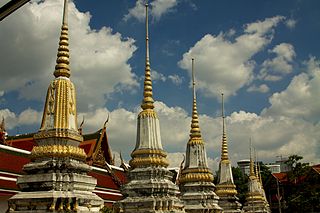
Wat Pathum Khongkha Ratchaworawihan, or simple known as Wat Pathum Khongkha is a second class royal temple in the Talat Noi area of Bangkok's Chinatown near Tri Mit Road, which leads to Odeon Circle, the beginning of Yaowarat Road.
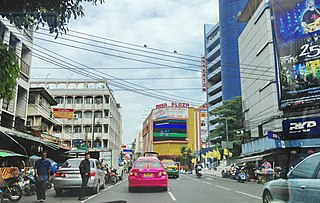
Chakkrawat is a khwaeng (subdistrict) of Samphanthawong district, Bangkok.
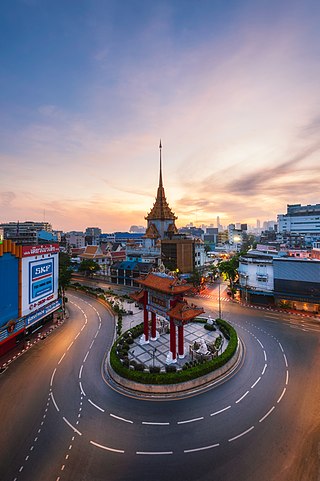
Samphanthawong is one of the three khwaeng (subdistrict) of Samphanthawong district, Bangkok, regarded as the main area of the district.
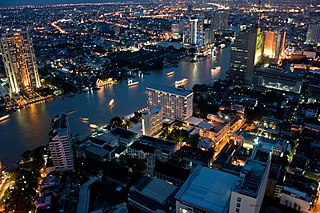
Bang Rak is a khwaeng (subdistrict) and historic neighbourhood in Bangkok's Bang Rak District. It lies between the Chao Phraya River and Charoen Krung Road, and was home to communities of European expatriates who settled in the area mostly during the second half of the 19th century as Siam opened up to the West. Among them were the Portuguese, French and British, whose embassies occupied extensive grounds in the area, Danes who founded shipping companies as well as the historic Oriental Hotel, and Catholic missionaries who established some of the first schools in the country on the grounds surrounding Assumption Cathedral.

The Thonburi city moat is the collective name of many several waterways in the form of moats on the Thonburi side or the west bank of the Chao Phraya river, location of Thonburi Kingdom, the former capital of Thailand between the years 1767 to 1782 ruled by a single monarch, King Taksin.


